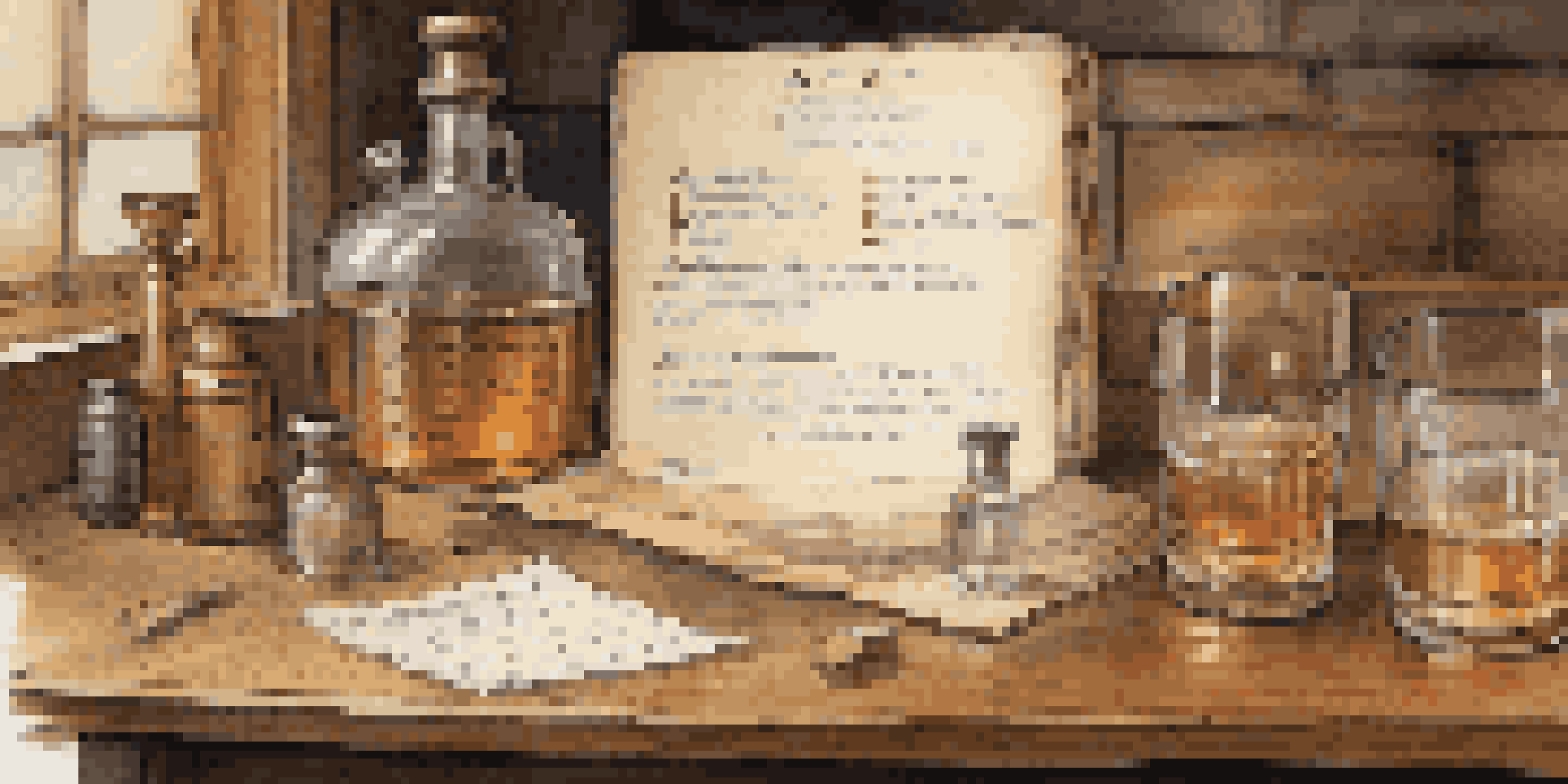How to Create a Distillation Log for Your Home Spirits

Understanding the Importance of a Distillation Log
A distillation log is an essential tool for any home distiller. It helps you track your process and outcomes, ensuring consistency in flavor and quality. Just like a chef keeps a recipe book, a distiller benefits from documenting each batch to refine their craft over time.
The only way to do great work is to love what you do.
By maintaining a detailed log, you can identify patterns and make informed adjustments to your methods. For instance, if a particular batch turned out exceptionally well, you’ll want to replicate the conditions that led to that success. Conversely, if a batch misses the mark, your notes will guide you in troubleshooting the issue.
Moreover, a well-kept distillation log can also serve as a valuable resource for sharing your techniques with fellow enthusiasts. It can foster a sense of community and learning, as others can benefit from your experiences and insights.
Choosing the Right Format for Your Distillation Log
When it comes to keeping a distillation log, the format can vary based on personal preference. Some distillers opt for a simple notebook, while others prefer digital tools or spreadsheets for easier data management. The key is to choose a method that you will consistently use and that allows for easy updates.

Consider including sections for each important aspect of the distillation process, such as ingredients, temperatures, and times. A structured format not only makes it easier to input data but also simplifies the review process later on. For example, a digital file can include dropdowns for easy selections and calculations.
Importance of a Distillation Log
A distillation log tracks your process and outcomes, ensuring consistency in flavor and quality.
Ultimately, the right format should enhance your distillation experience, making it enjoyable and efficient. Whether you go old-school with pen and paper or embrace technology, the goal is to create something that works for you.
Key Components to Include in Your Distillation Log
To make your distillation log comprehensive, there are several key components to include. Start with basic information such as the date, batch number, and type of spirit you’re distilling. This foundational data provides context for each entry and helps you track your progress over time.
Success is the sum of small efforts, repeated day in and day out.
Next, document the ingredients used, including specific quantities and any variations you may have made. For instance, if you decide to experiment with different yeast strains or fruit types, noting those changes can lead to exciting new flavors. Recording such details can be the difference between a memorable batch and a forgettable one.
Lastly, don’t forget to log your observations during the distillation process. Describing the aroma, taste, and any challenges encountered can provide invaluable insights for future efforts. These notes enrich your learning experience and help cultivate your unique distilling style.
Recording Temperatures and Distillation Times
Temperature and time are two crucial factors that significantly influence the quality of your spirits. Recording these details can help you understand how different variables affect the distillation process. For instance, if you notice that a batch distilled at a higher temperature results in harsher flavors, you may opt for a lower temperature next time.
It’s also helpful to track the duration of each distillation phase, as this can vary depending on the ingredients and desired outcomes. A longer distillation time might yield richer flavors, while a quicker process could produce a lighter spirit. By keeping accurate records, you can replicate successful batches more easily.
Key Components to Document
Include essential details like date, ingredients, and observations to enhance your distillation practice.
Incorporating a temperature chart or timeline in your log can enhance clarity. You can visually see the relationship between temperature changes and flavor profiles, making it easier to make informed adjustments in the future.
Documenting the Tasting Notes and Feedback
Tasting notes are an integral part of your distillation log, capturing the nuances of flavor, aroma, and mouthfeel. After each distillation, take the time to savor your creation, noting anything that stands out. This practice not only enhances your palate but also helps you refine your distilling techniques over time.
Consider using a descriptive scale for different aspects of your spirit, such as sweetness, bitterness, and complexity. This can provide a clearer understanding of how your techniques affect the final product. For example, you might rate a batch a 7 out of 10 for sweetness, prompting you to adjust sugar levels in your next recipe.
Additionally, don’t hesitate to seek feedback from friends or fellow distillers. Their perspectives can offer fresh insights and help you identify areas for improvement, turning your distillation journey into a collaborative experience.
Storing and Organizing Your Distillation Log
Once you start accumulating records, organizing your distillation log becomes paramount. A cluttered log can lead to confusion, making it difficult to reference past batches. Whether you choose a physical notebook or a digital format, ensure that it’s easy to navigate and update.
If you’re using a digital spreadsheet, consider categorizing entries by spirit type or date for easy access. You might create tabs for different types of spirits, allowing you to quickly find relevant information. For handwritten logs, a simple index at the front can save you time when searching for specific entries.
Review and Analyze Your Data
Regularly reviewing your log helps identify patterns and improve your distilling techniques over time.
Maintaining organization in your log not only boosts efficiency but also enhances your overall distillation experience. A well-structured log can inspire you to experiment more and track your progress effectively.
Reviewing and Analyzing Your Distillation Data
Regularly reviewing your distillation log can provide invaluable insights into your distilling journey. Set aside time to analyze your entries, looking for patterns or trends that emerge over time. This reflection can help you identify successful techniques and areas that need improvement.
For example, if you notice that certain ingredients consistently yield better results, you might choose to focus on those in future batches. Alternatively, if a particular method often leads to undesirable flavors, you can adjust your approach accordingly. This iterative process is key to mastering your craft.

Additionally, consider creating summary notes or charts based on your findings. A visual representation of your progress can be both motivating and enlightening, encouraging you to keep refining your distillation skills.